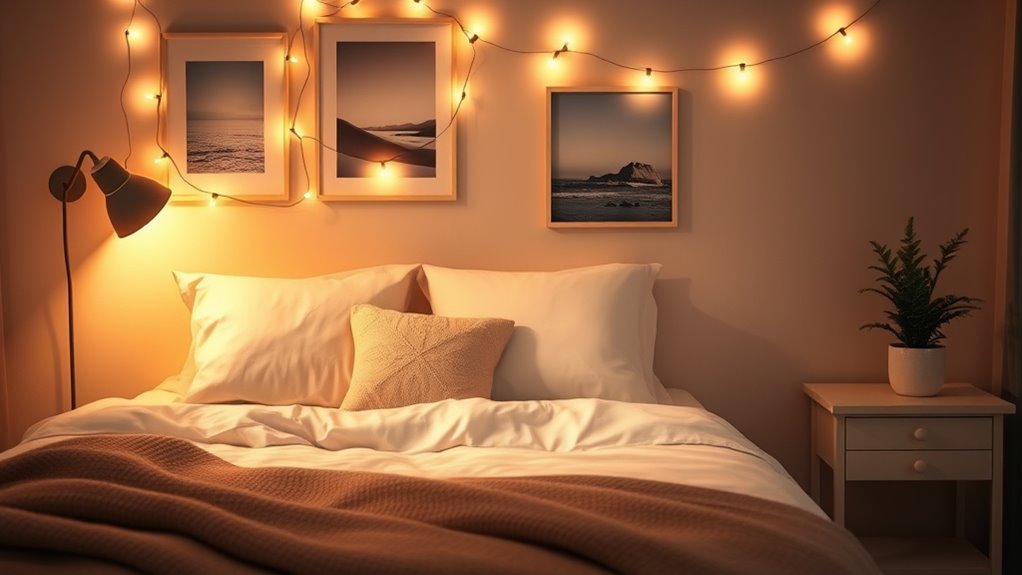Creating a calm, clutter-free bedroom with soothing colors, soft lighting, and comfortable textures sets the perfect mood for sleep. Maximize darkness with blackout curtains, control the temperature and ventilation, and reduce noise with soundproofing or white noise. Personal touches and a peaceful layout make your space inviting and relaxing. By adopting these decorating habits, you can markedly improve your sleep quality. Keep going to discover more simple tips to transform your sleep environment.
Key Takeaways
- Incorporating calming colors like soft blues and greens creates a tranquil environment that promotes relaxation and better sleep.
- Using soft, indirect lighting with warm tones signals your body to wind down and improves sleep quality.
- Minimizing clutter and optimizing storage reduces visual stress, helping your mind relax before bedtime.
- Maximizing darkness with blackout curtains and controlling light sources supports melatonin production for restful sleep.
- Adding soothing scents such as lavender or bergamot fosters calmness and enhances sleep comfort.
Prioritize Soothing Colors in Your Bedroom Palette
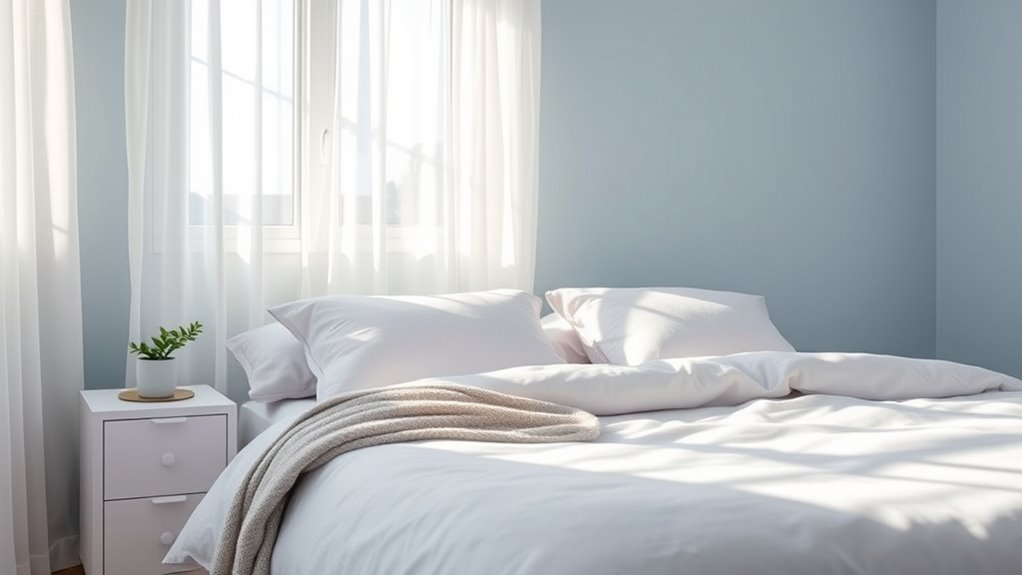
Choosing calming colors for your bedroom can considerably improve your sleep quality. Incorporating soothing colors like soft blues and greens into your bedroom decor creates a tranquil sleep environment that signals your brain it’s time to rest. These gentle hues help lower cortisol levels, promoting relaxation and reducing stress. When you select a limited palette of calming tones, your space feels more unified and peaceful, making it easier to unwind at night. Textured wall coverings in warm shades, like linen or silk, add warmth and coziness, enhancing emotional comfort. Personalizing your color scheme with your preferred calming tones can also boost your sense of well-being. Additionally, glycolic acid skincare routines can help improve skin texture and radiance, contributing to an overall feeling of well-being that supports restful sleep. Overall, prioritizing soothing colors helps establish a restful atmosphere, encouraging better sleep habits and improved sleep quality.
Incorporate Soft, Indirect Lighting for Relaxation
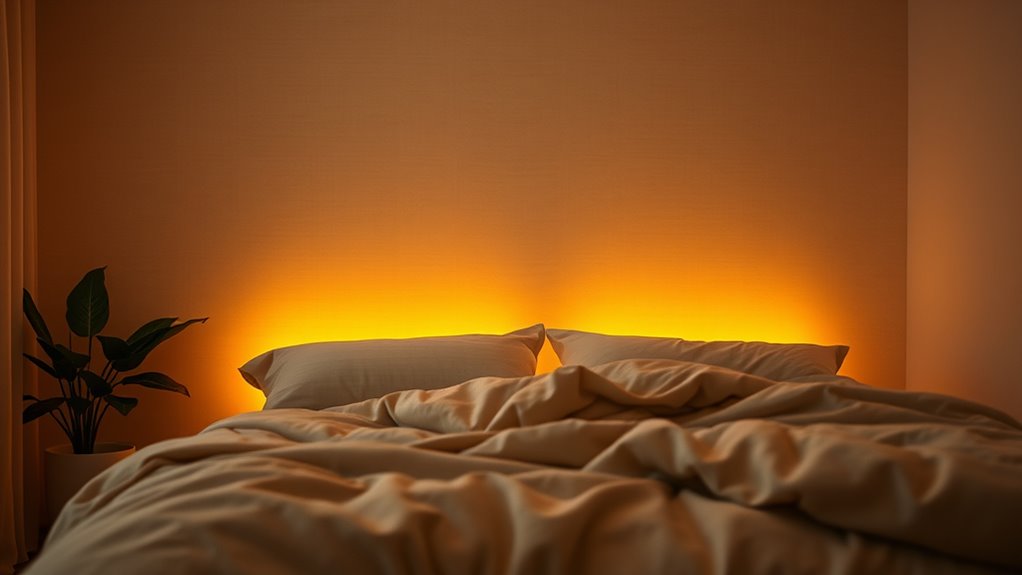
Incorporating soft, indirect lighting into your bedroom creates a calming environment that signals your body it’s time to relax. Indirect lighting, such as bedside lamps or wall sconces, helps promote relaxation and boosts melatonin production, essential for quality sleep. Using dimmable lamps or warm-colored bulbs in the evening creates a soothing atmosphere that encourages your body to wind down naturally. Avoid bright, direct overhead lights, as they can disrupt your circadian rhythm and hinder sleep onset. Studies show that exposure to low-intensity, indirect light before bed improves both sleep duration and quality. Studies on sleep environment reveal that optimizing your sleep surroundings can significantly enhance sleep quality. Incorporating natural elements like plants can further enhance the tranquil ambiance of your sleep space. By establishing gentle, ambient lighting, you set a peaceful tone for sleep, making it easier to *shift* into restful slumber and wake refreshed.
Use Textures That Promote Comfort and Calmness
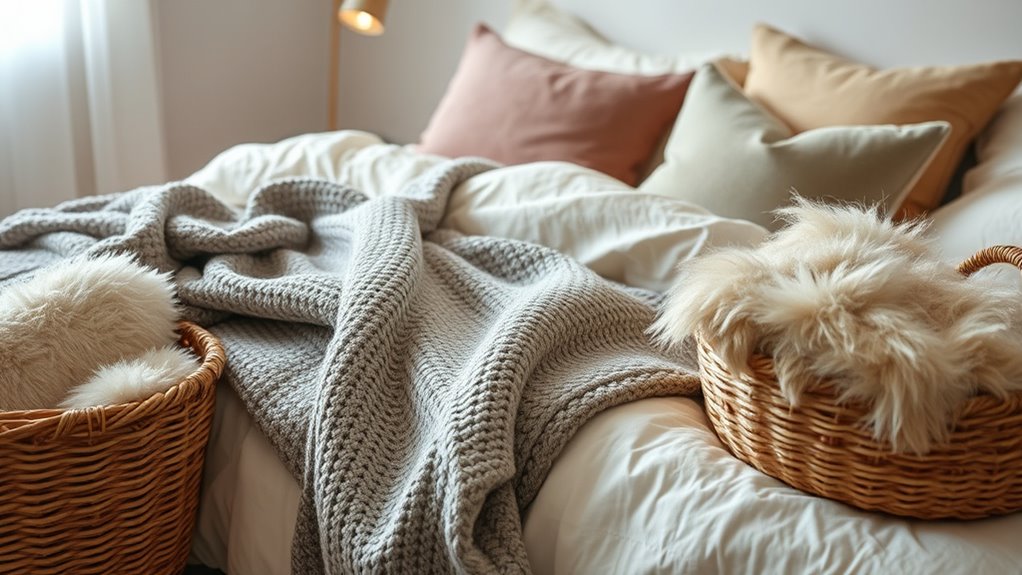
To create a calming bedroom environment, incorporating soft textures like cotton, wool, or linen in your bedding and upholstery makes a noticeable difference. These soft textiles enhance tactile comfort, making your space feel cozy and inviting. Using textured wall coverings such as silk or linen adds visual warmth and adds to the tactile experience, fostering a sense of tranquility. Combining plush rugs with smooth bedding stimulates your senses, signaling your body it’s time to relax. High-quality, breathable fabrics help regulate temperature, reducing discomfort and promoting better sleep. Soft textures lower stress levels and create a peaceful ambiance, making your bedroom a sanctuary of calmness. Incorporating sleep environment through textured materials can further enhance relaxation and sleep quality. Additionally, selecting vibrational alignment in your decor choices can contribute to a more restful atmosphere. By thoughtfully choosing tactile materials, you support a toilet flushing environment that encourages deep, restorative sleep. Creating a harmonious sensory environment with these textures can significantly improve your overall sleep experience.
Minimize Clutter for a Peaceful Environment

Keeping your surfaces clear and organized can instantly make your bedroom feel more peaceful. Using storage solutions helps prevent clutter from piling up, and limiting personal items reduces visual distractions. When you minimize clutter, you create a calming space that promotes better sleep and relaxation. Incorporating test case management tools into your organization routine can further streamline your efforts and maintain a clutter-free environment. Additionally, adopting organizational practices inspired by Bollywood Legends’ enduring impact can help you develop long-term habits that sustain a peaceful, tidy space. Embracing mindful decluttering strategies can also support your goal of maintaining a serene bedroom environment. Being mindful of environmental considerations, such as minimizing your ecological footprint, can enhance the tranquility of your space. Understanding psychological effects of clutter can motivate you to stay committed to your organization efforts.
Clear Surfaces Regularly
Regularly clearing surfaces can substantially reduce visual clutter, helping your mind feel more at ease as you prepare for sleep. When your space is free of unnecessary items, it minimizes distractions and creates a calming environment. Clutter increases stress and cortisol levels, which interfere with relaxation and delay sleep onset. A tidy bedroom promotes mental clarity and signals to your brain that it’s time to wind down. Keeping surfaces clear helps prevent feelings of being overwhelmed and makes your space more inviting. Incorporating home organization practices can further support a peaceful environment. By establishing a routine of decluttering, you support relaxation and improve your sleep quality over time. Less visual chaos means your mind can shift smoothly into rest, making it easier to fall asleep and stay asleep throughout the night. Additionally, understanding how merchant services can facilitate seamless transactions may reduce stress related to financial concerns, contributing indirectly to your overall relaxation. Engaging in consistent creative practice routines can also foster a sense of control and calmness before bed, enhancing overall sleep quality. Furthermore, research indicates that sound healing science shows that calming sounds or frequencies can promote deeper, more restful sleep. Incorporating sleep hygiene strategies, such as reducing screen time before bed, can further enhance sleep quality by supporting your relaxation efforts.
Use Storage Solutions
Using effective storage solutions, such as under-bed drawers or closet organizers, can considerably reduce clutter and create a more peaceful bedroom environment. When you keep your space organized, it becomes easier to maintain, making cleaning less stressful and more efficient. Properly arranged shelves and cabinets prevent items from piling up, helping you eliminate visual stressors that can interfere with relaxation. Minimizing clutter through smart storage options also reduces distractions, allowing your mind to unwind more easily. Studies link a tidy, well-organized bedroom to better sleep quality by promoting a sense of order and security. Incorporating space optimization techniques can further enhance the functionality of your storage solutions. Additionally, selecting storage solutions that maximize vertical space can make a significant difference in small rooms. Using self-watering plant pots as part of your decorative elements can also add a calming, natural touch to your space, contributing to a tranquil environment. Implementing rustic decor can reinforce the farmhouse aesthetic and create a cozy atmosphere. Utilizing multi-functional furniture can help you make the most of limited space while maintaining a clutter-free environment. By choosing the right storage solutions, you’re not only creating a visually calming space but also supporting your mental well-being and overall sleep environment.
Limit Personal Items
Organizing your space goes beyond just storage solutions—limiting personal items and excess decor plays an essential role in creating a calming bedroom environment. Clutter can heighten stress and hinder relaxation, making it harder to fall asleep. By maintaining a tidy space, you reduce visual distractions, helping your mind unwind more easily before bed. Regular decluttering fosters a sense of order that’s linked to improved mental health and sleep quality. Limiting personal items prevents feelings of being overwhelmed and promotes a calm, restful atmosphere. A minimalist approach to decor encourages deeper, more restorative sleep. To achieve this, consider:
- Removing unnecessary personal belongings
- Limiting decorative items on surfaces
- Keeping only essentials visible and accessible
This simple step makes a significant difference in enhancing your sleep environment.
Maximize Darkness With Blackout Curtains or Shades
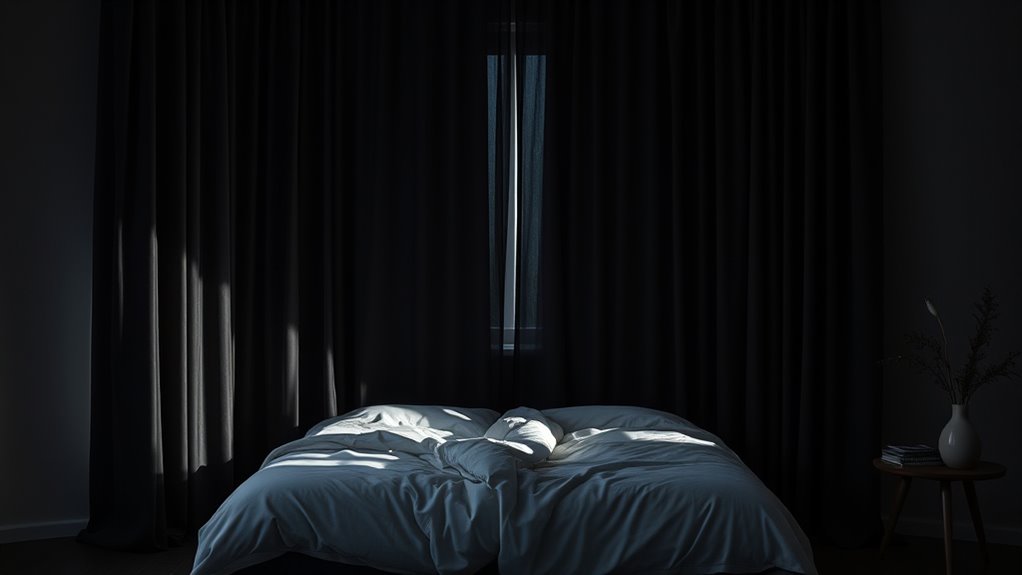
You can considerably improve your sleep by blocking out external light sources with blackout curtains or shades. These window treatments are designed to create a dark environment, helping your body produce melatonin naturally. Properly installed, they also regulate temperature, making your bedroom even more sleep-friendly.
Block Exterior Light Sources
Blocking exterior light sources is a crucial step in creating a sleep-friendly environment, especially in urban areas where streetlights, passing cars, and outdoor illumination can disrupt rest. Installing blackout curtains or shades effectively blocks up to 99% of external light, reducing light pollution and fostering melatonin production. This creates a darker space that encourages longer, more restorative sleep cycles. Properly fitted blackout window treatments can also minimize nighttime awakenings caused by outside light, promoting consistent sleep patterns. In high light pollution areas, these coverings are especially beneficial, helping you establish a darker, calmer bedroom. By preventing outside light from interfering, you notably improve sleep quality and support your body’s natural circadian rhythms.
- Reduce light pollution for better sleep
- Limit disturbances from streetlights and passing vehicles
- Create a consistent, dark environment to enhance rest
Choose Light-Blocking Window Treatments
Choosing the right light-blocking window treatments is essential for maximizing darkness and improving sleep quality. Blackout curtains or shades can block up to 99% of external light, creating a darker environment that supports melatonin production. By reducing light exposure, you’ll find it easier to fall asleep and stay asleep longer, especially in urban areas with streetlights or early dawn light. Installing blackout window coverings helps regulate your circadian rhythms by maintaining consistent darkness throughout the night. Studies show that bedrooms with blackout curtains increase sleep efficiency by 50%, leading to more restorative rest. Proper window treatments are a simple yet effective way to minimize disruptive light, helping you achieve deeper, more restful sleep every night.
Introduce Gentle Scents to Foster Calmness

Introducing gentle scents into your bedroom creates a calming atmosphere that can considerably enhance your sleep quality. Using essential oils like lavender, geranium bourbon, or bergamot can promote relaxation and help you unwind. Incorporate diffusers made from Irish plants or natural extracts to create a soothing scent environment that supports restful sleep. Subtle, pleasant aromas activate your brain’s emotional centers, reducing stress and anxiety before bed. Replacing strong or unpleasant odors with calming scents prevents sleep disruptions caused by olfactory discomfort. A thoughtfully scented space makes your bedroom feel more inviting and conducive to falling asleep quickly. To elevate the ambiance, consider:
Creating a calming, scented space with essential oils promotes restful sleep and reduces stress.
- Using high-quality essential oils in a diffuser
- Choosing natural extracts with proven calming effects
- Regularly invigorating scents to maintain a soothing atmosphere
Maintain Optimal Temperature and Ventilation
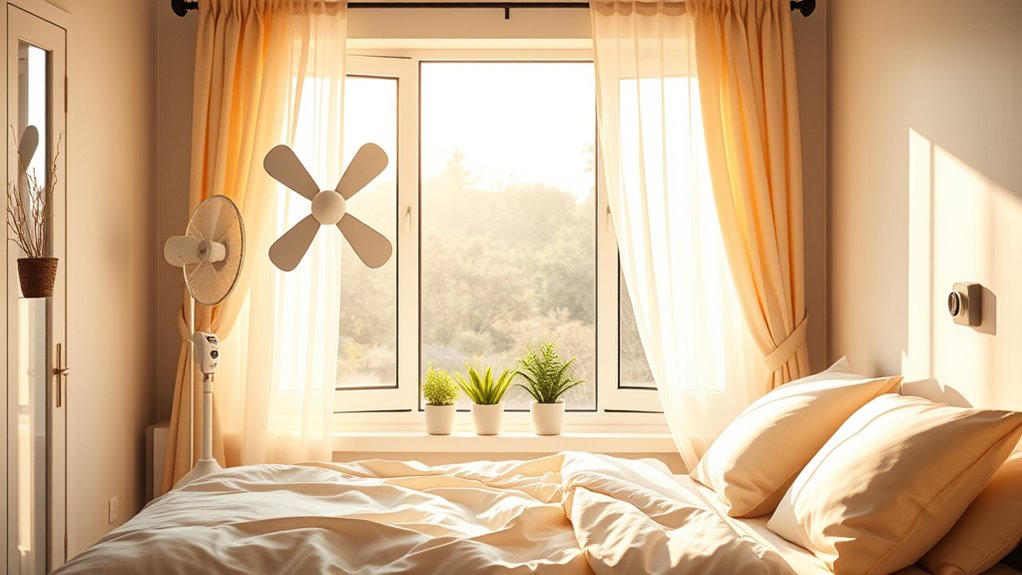
Creating a calming bedroom environment goes beyond scent; maintaining the right temperature and fresh air flow is essential for restful sleep. Keep your bedroom temperature between 60 to 71°F (15.6 to 22°C) to support ideal sleep quality, as cooler environments help regulate your body temperature. Enhance ventilation by using fans or opening windows, ensuring a continuous supply of fresh air. Good air quality is vital; poor air circulation, excess humidity, and allergens can disrupt your sleep and cause breathing problems. Regularly cleaning and ventilating your room reduces dust, mold, and indoor pollutants that impair sleep health. Proper airflow and a cool, well-ventilated space make it easier to fall asleep, stay asleep, and wake feeling refreshed.
Reduce External Noise With Soundproofing or White Noise
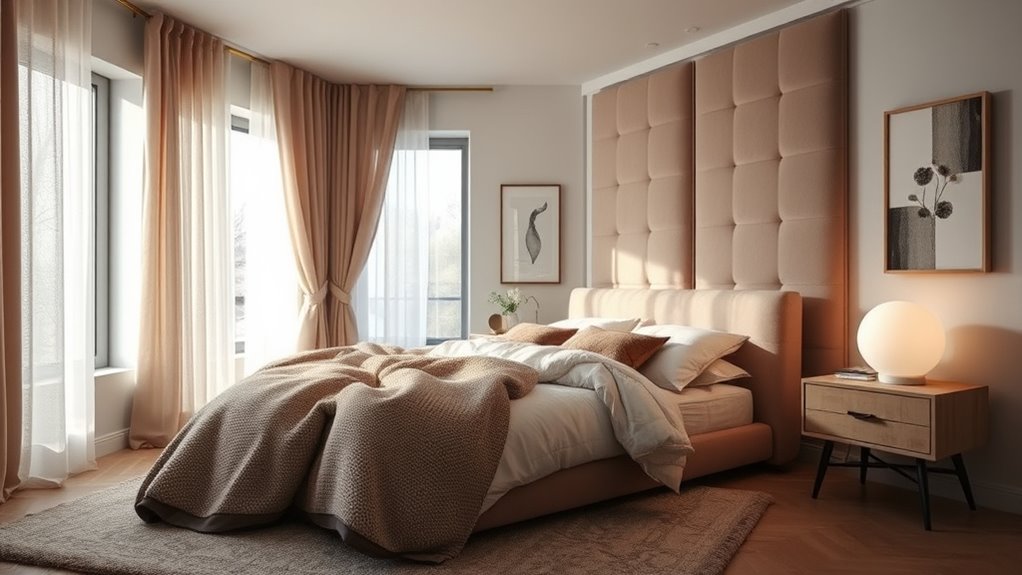
Have you ever been kept awake by outside noises disrupting your sleep? Reducing external noise is vital for better rest. You can achieve noise reduction through effective soundproofing and white noise. Consider installing acoustic panels or double-glazed windows to block out disruptive sounds, creating a quieter environment. Thick, floor-length curtains and area rugs also absorb sound waves, further minimizing noise. Using white noise machines or fans provides a consistent background sound that masks sudden noises, helping you fall asleep faster and stay asleep longer. These methods work together to create a tranquil space conducive to restorative sleep.
Reduce outside noises with soundproofing and white noise for better sleep.
- Incorporate soundproofing elements like acoustic panels and double-glazed windows
- Use white noise devices or fans for consistent noise masking
- Add thick curtains and rugs to absorb sound within the room
Choose Sleep-Enhancing Bedding and Pillows
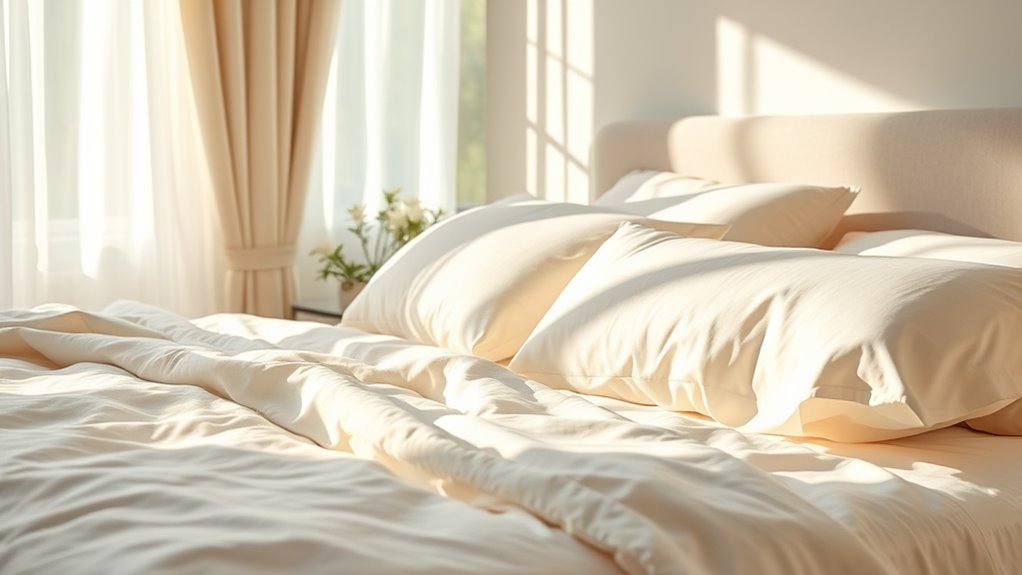
Choosing the right bedding and pillows can substantially improve your sleep quality by providing proper support and comfort. Opt for high-quality bedding made from natural fibers like linen or long-fiber cotton, which help regulate temperature and keep you cozy throughout the night. Memory foam pillows or those with adjustable fill offer personalized support, reducing neck strain and ensuring proper spinal alignment. Proper pillows can also alleviate back pain and enhance overall sleep comfort. Regularly washing your sheets and pillowcases keeps allergens at bay, creating a cleaner, more hygienic environment. Incorporate cooling pillow inserts or scent-infused bedding if you want to promote relaxation further. By selecting sleep-enhancing bedding and pillows, you create a more supportive, restful sleep space that encourages deep, restorative sleep.
Establish a Consistent, Peaceful Layout and Personal Touches
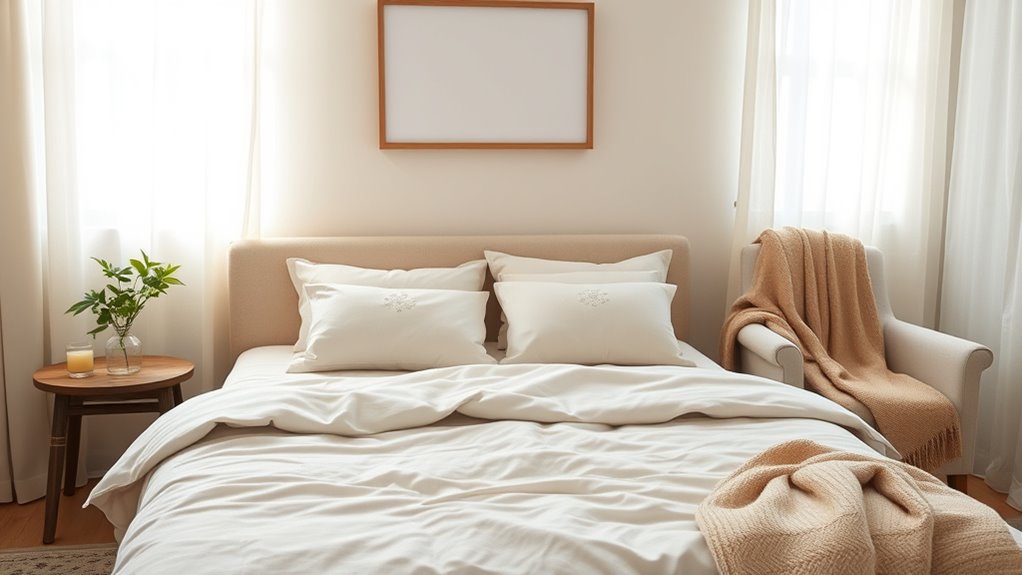
Arranging your bedroom thoughtfully can markedly boost your sense of security and relaxation, making it easier to fall asleep. Keep your bed in a command position, where you can see the door without being directly in line with it, to promote psychological comfort. An organized space with a simple layout reduces visual clutter, lowering stress and encouraging relaxation. Adding personal touches like meaningful photos or objects makes your space more inviting and emotionally soothing. To enhance this, consider:
Arrange your bedroom with balance and personal touches to create a calming, secure retreat that promotes restful sleep.
- Centering and balancing your bed within the room
- Keeping surfaces clear and free of clutter
- Incorporating familiar, comforting decor
These steps create a harmonious environment that supports restful sleep and fosters a peaceful atmosphere, making your bedroom a true retreat for relaxation.
Frequently Asked Questions
What Are Some Effective Habits for Improving Sleep?
To improve your sleep, you should establish a consistent schedule, going to bed and waking up at the same times. Create a calming bedtime routine like reading or meditating, and avoid screens at least an hour before sleep. Keep your bedroom cool, dark, and quiet, and maintain a clutter-free space with soothing colors and scents. These habits help regulate your circadian rhythm and promote restful, restorative sleep.
What Improves Quality of Sleep?
You might think sleep quality depends only on your body, but your environment plays a huge role. Keep your bedroom cool, dark, and quiet to support your natural rhythms. Use comfy bedding and pillows that suit you. Limit blue light from screens before bed and guarantee good air quality. A tidy, calming space with a consistent routine helps you fall asleep faster and enjoy deeper, more restorative rest.
What Is the Simple Habit That Leads to Better Sleep?
The simple habit that leads to better sleep is creating a dedicated, clutter-free sleeping space. You should make your bedroom dark, cool, and quiet, which helps your body relax and associate the environment with rest. Keep your bed area tidy and personalized to promote calmness. By doing this consistently, you signal to your body that it’s time to wind down, making it easier to fall asleep and stay asleep throughout the night.
What Is the 10 5 3 2 1 Rule for Sleep?
The 10 5 3 2 1 rule is your secret weapon for epic sleep! It tells you to stop caffeine 10 hours before bed, avoid heavy meals, alcohol, and fluids 3 hours before, turn off screens 2 hours prior, and wind down 1 hour before sleep. Follow these steps to tame your sleep chaos, so you can wake up refreshed, energized, and ready to conquer the day!
Conclusion
By transforming your bedroom into a sanctuary of calm, you’re planting the seeds for better sleep. Think of it as tuning an instrument—you’ll find everything harmonizes when your space is soothing, clutter-free, and comfortable. Small changes, like soft lighting and cozy textures, work like magic, turning your nights into peaceful retreats. Embrace these habits, and watch your sleep blossom—because when your environment feels right, restful nights become your new normal.
